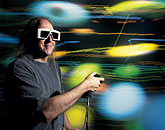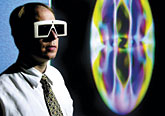A team of computer scientists at the National Institute of Standards and Technology is inventing new ways to study the most common'and the rarest'substances on Earth.The scientists specialize in visualization techniques to show their colleagues in physics and materials science the results of complex simulations running on powerful parallel computers.They can image, for example, random movements of particles inside wet concrete. They can picture small knots of atoms in a state of matter so unusual that it wasn't created in the laboratory until 70 years after theorists predicted it.On the surface, the scientific collaborations appear very different, said Judith E. Devaney, leader of the Scientific Applications and Visualization Group at NIST's Information Technology Laboratory in Gaithersburg, Md. But the specialties'parallel computing, data mining and visualization'are alike because all involve pattern recognition.Scientists at other NIST labs in Gaithersburg and Boulder, Colo., devise the basic algorithms for the virtual experiments. Programmers in Devaney's group convert the models to detailed programs for NIST's parallel computers. Then the visualization specialists transform the data sets into pictures or movies for easier understanding.Devaney and her colleagues regard the process as a feedback loop that proceeds from theory through development of a basic model, sometimes altering the theory.'It's a fairly tight loop because the goal is always to have more realistic models,' Devaney said. 'You want to make sure the scientists get what they need so they can move on to the next step.'Devaney's group collaborates with NIST's Building and Fire Research Laboratory to study concrete, the most widely used manmade product.The building research lab recently organized a consortium called the Virtual Cement and Concrete Testing Laboratory, with a Web site at . Companies join the consortium to get access to NIST's expertise.'The computer codes are at the point now where it is considered realistic' to move concrete testing into the virtual world, Devaney said. Simulating new types of concrete, instead of mixing up physical samples, not only saves money but also could lead to new forms of concrete with greater crack resistance or special colors.Devaney's group is developing the visible cement data set, a virtual experiment depicting hydration, or formation of chemical bonds between water molecules and other substances in the mix. When the data set is finished later this year, it will go on the Web for all to use, Devaney said.NIST concrete researchers also participate in another area of the visualization group's research: so-called immersive computing, in which scientists get up close and personal with large, colorful representations of their data.In the photograph on Page 1, NIST computer scientist Steven G. Satterfield demonstrates a 3-D cement flow based on a numerical simulation by materials scientist Nicos S. Martys.The model computed how ellipsoidal cement particles, oriented randomly within a cube-shaped volume, would line up based on shear forces. In three dimensions, the multicolored, blimplike objects followed jagged lines like beads on a wire. The colored lines showed the paths.To get that immersive feeling, the NIST visualization group uses a Reconfigurable Automatic Virtual Environment (RAVE) device from Fakespace Systems Inc. of Kitchener, Ontario.The setup consists of an 8-foot-square screen with a 1,280- by 1,024-pixel display. A 12-processor SGI Onyx 3000 visual supercomputer in the RAVE system generates two images, one for each eye, with polarized glasses to help the observer's brain assemble the two images into a single 3-D vision.Casual viewers could use plain polarized glasses, but concrete researchers might turn to the wired Crystal Eyes headset from StereoGraphics Corp. of San Rafael, Calif., which tracks the observer's head movements.'The image actually changes as you move your head around,' Satterfield said, and observers feel as if they are squeezing through the wet concrete.A flashlight effect in the RAVE system's control wand casts a white spot where the wand points.The software behind the RAVE hardware is a graphics file loader called DIVERSE, for device-independent virtual environments'reconfigurable, scalable, extensible. The open-source software came from Virginia Polytechnic Institute, at . DIVERSE reads the positions of the head-tracking goggles and the control wand.'Scientists work on the experiments, they work on the math, they have this sort of in-their-head notion about what's going on,' Satterfield said of the immersive environment. 'When you bring it to life, they say 'Oh yeah, that's exactly it,' or 'No, that's not it,' or 'That's it, but that thing's wiggling funny like it's not right.' And then they go back and look at the math.'The next step in improving the simulations will be to replace the ellipsoids with more realistic particles of uneven size, ragged shapes and differing chemical properties, Satterfield said.Devaney's group has posted some Apple QuickTime versions of the concrete flow simulations at . The movies lack the 3-D effect and interactivity.Peter M. Ketcham, another computer scientist in the visualization group, said he works with NIST physicists to picture their models of the microscopic phenomenon known as Bose-Einstein condensation.A Bose-Einstein condensate is a state of matter in which a cluster of supercold atoms starts to behave as a single entity at a few billionths of a degree above absolute zero. Scientists predicted the quantum-physics effect in the mid-1920s, but not until 1995 was the phenomenon demonstrated.Ketcham worked with six NIST colleagues and a collaborator from the University of Washington to turn the physicists' computer models into movies.Their 3-D simulation of a cluster of rubidium atoms contains 8 million data points. Going against custom, NIST designated low-density regions as bright and high-density regions as dark to see if the low-density areas would develop tiny whirlpools, or vortices. In the simulation, the vortices showed up as bright vertical, tornadolike bands.At the time of the visualization research, physicists were hotly debating the existence of such vortices, Ketcham said. An equatorial ring in early versions of the simulation had no physical reality. 'Essentially it was the result of a mistake in the simulation,' he said.The feedback loop between the visualization group and the researchers brought improvements to the simulation, and the ring disappeared.
Steven G. Satterfield, a NIST computer specialist, studies a 3-D visualization of idealized particles inside wet concrete using a RAVE device.
The aim of the visualizations is to improve research, NIST's Judith E. Devaney says.
NIST's Peter M. Ketcham views a 3-D simulation of a Bose-Einstein condensate, a state of matter in which a cluster of supercold atoms starts to behave as a single entity.









